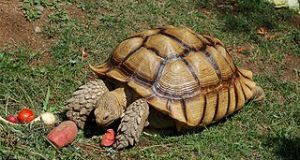 I have run across colonies of feral sliders in Nassau (Bahamas), Baja California, Nevada, northern California, Japan (including in temple ponds in historic Kyoto!), Venezuela, St. Lucia and St. Croix. Such sightings, of course, are not noteworthy, considering that this plucky survivor is well established in 25 or more countries on all continents except Antarctica (actually, when referring to animals with large ranges it’s standard to state “except Antarctica“…I’m not so sure this applies here for all I know there may be one paddling about some researcher’s outdoor hot tub!). Parks in Korea, marshes in Brazil, ponds on Guam and countless other far-flung habitats all have their resident sliders.
I have run across colonies of feral sliders in Nassau (Bahamas), Baja California, Nevada, northern California, Japan (including in temple ponds in historic Kyoto!), Venezuela, St. Lucia and St. Croix. Such sightings, of course, are not noteworthy, considering that this plucky survivor is well established in 25 or more countries on all continents except Antarctica (actually, when referring to animals with large ranges it’s standard to state “except Antarctica“…I’m not so sure this applies here for all I know there may be one paddling about some researcher’s outdoor hot tub!). Parks in Korea, marshes in Brazil, ponds on Guam and countless other far-flung habitats all have their resident sliders.
It is, however, in New York where I have had most of my experience with feral populations. Sliders, usually originating as released pets, are very common in waterways within NYC, but may also be found in relatively isolated areas as well.
Natural Habitat
Quiet, mud-bottomed waters with abundant vegetation and basking sites are considered to be the typical habitat in the northern part of the range, while tropical slider subspecies tend to occupy large rivers. “Typical”, however, is a quite plastic concept as concerns this adaptable turtle.
New York‘s Resident Sliders
 In New York, I have encountered red-eared sliders such unlikely habitats as Pine Barren’s cranberry bogs with highly acidic waters, shaded, fast-moving streams and tidal creeks bordering the Great South Bay (please see photographs). They are also to be found in the Hudson River along the west side of Manhattan, watering holes in outdoor exhibits at the Bronx Zoo and in just about every park pond within NYC…the various natural and artificial waterways of Central and Prospect Parks have amazingly dense populations.
In New York, I have encountered red-eared sliders such unlikely habitats as Pine Barren’s cranberry bogs with highly acidic waters, shaded, fast-moving streams and tidal creeks bordering the Great South Bay (please see photographs). They are also to be found in the Hudson River along the west side of Manhattan, watering holes in outdoor exhibits at the Bronx Zoo and in just about every park pond within NYC…the various natural and artificial waterways of Central and Prospect Parks have amazingly dense populations.
Along one stretch of the Bronx River which I have frequented since childhood, partially submerged shopping carts and car hoods are the most frequently used basking sites (the few logs that are available are rarely occupied by turtles!).
Further Reading
 Detailed maps of the slider’s range in North America, as well as the US Geological Survey’s assessment of its impact on non-native habitats are posted at http://nas.er.usgs.gov/queries/FactSheet.asp?speciesID=1261
Detailed maps of the slider’s range in North America, as well as the US Geological Survey’s assessment of its impact on non-native habitats are posted at http://nas.er.usgs.gov/queries/FactSheet.asp?speciesID=1261
 That Reptile Blog – Reptile, Amphibian and Exotic Pet Care and Information
That Reptile Blog – Reptile, Amphibian and Exotic Pet Care and Information


